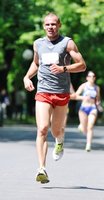Recover from Hitting the Wall
Hitting the wall sounds like a violent, painful activity. It's not literally "hitting the wall", but feeling like you've hit something when you run out of carbohydrate energy. Runners become weak, dizzy, experience headaches, blurred vision, and more. It frequently happens when running a full marathon, generally after 18 or so miles. The most common period is between 20-23 miles.
Hitting the wall is also known as a "bonk" or "bonking".
Your body has two primary sources of energy, glycogen (carbs), and fat. Fat is stored in adipose tissue, just under the skin, throughout your body. Glycogen is stored in your liver and muscles. The average person stores about 500 grams of glycogen (better trained athletes and more muscular athletes store more) in the body. This is about 2,000 calories of energy. Fat reserves are much larger, even lean athletes store more than 50,000 calories in their fat tissue. The problem in running, however, is that the body favors using glycogen over fat.
You hit the wall when your glycogen reserves are less than 10%. Your body needs glycogen for energy, but also to burn fat for energy. Inadequate glycogen will shut you down!

The best way to cope with hitting the wall is to not hit it at all. There are two strategies to avoid the wall, you can do one or both. The first strategy is to go slow, a slower pace will favor a higher percent of fat burning, saving your precious glycogen. The second strategy is to eat carbs early and frequently throughout the race. You should aim for about 200 carb calories per hour in the race, which you can get from sports drink, gels, and food. It's a good idea to practice eating in training runs before you race, as it takes some time for a person's stomach to adapt to digestion while running. Walking for a few minutes, right after you've taken in calories, is helpful to many people to tolerate food during a race.
But if you do hit the wall in the race, you can still recover. It's not easy and it will take at least 20 minutes. Some people can still run through a bonk, albeit at a slower pace. Many people have to slow to a walk. In extreme cases, some runners must lie down and recover.
The absolute most important thing when you've hit the wall is to get in calories. Simple sugars are best:
- Sugary Sports Drinks
- Fruit Juice
- Soda Pop (not diet!)
- Candy
- Gels
- White Potato (excellent, but you probably won't have access to this)
- Fruit (watermelon, banana, orange slices)
When you've hit the wall, it's NOT the time to worry about eating healthy! It's all about getting sugar into your body so that you can recover. Although you want to get this into your body quickly, there are limits to how fast you can digest, and drinking/eating a lot at once can cause stomach upset. There's nothing worse than bonking and vomiting during a race!

You should aim for 150-250 calories to take in immediately after bonking. You will need to move slower for a while, and the slower pace will help you digest faster. When you start to feel better, you know the carbs have kicked in. You should plan to take in another 50-150 calories every 15-20 minutes after your intial dose, until you finish the race.
To summarize, when you've hit the wall:
- Find simple sugar calories
- Eat/Drink 150-250 calories
- Slow your pace to digest better
- Depending on your size, pacing, and what you can tolerate: take in 50-150 calories every 15-20 minutes until you finish the race.
By following this advice, you can still recover and finish decently in a marathon. It won't be as glorious or as fast as if you didn't hit the wall, but coming back from a big obstacle is something to be proud of!






